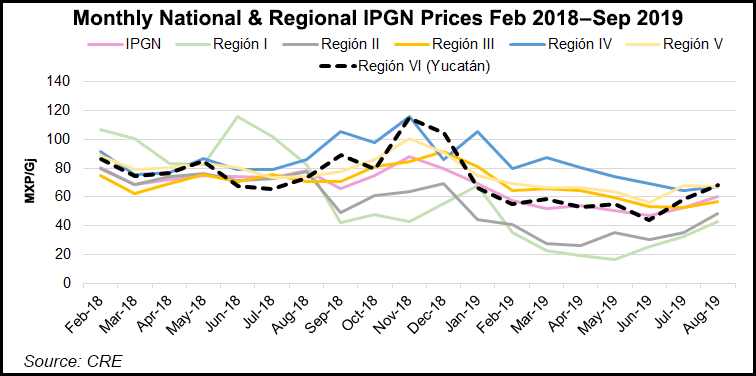Infrastructure | NGI All News Access
Cenagas to Open Bidding on Mayakan Interconnect, Will Ease Yucatán Gas Shortfall
Mexico’s pipeline operator Centro Nacional de Control del Gas Natural (Cenagas) will open bidding on an interconnection project connecting the Mayakan pipeline in the Yucatán peninsula to the national Sistrangas grid, according to the head of Cenagas, Elvira Daniel.

Although the bidding dates and rules have yet to be announced, investment in the 10-mile, 1Bcf/d project is expected to hit $25 million, according to energy consultancy Talanza.
The isolated 485-mile Mayakan pipe, majority-owned by France’s Engie SA, supplies natural gas to power plants and industry in the Yucatán peninsula. Mayakan sources its gas entirely from Nuevo Pemex, a natural gas processing center run by Mexican state oil company Petróleos Mexicanos (Pemex).
The interconnection project is seen as crucial to alleviating natural gas supply shortfalls that have caused power outages in the Yucatán over the past few years.
Mexican state utility Comision Federal de Electricidad (CFE), which holds 97% of the capacity on the pipeline, has attributed gas shortages to the “permanent state of force majeure” at the Abkatun Alfa marine platform offshore Mexico’s southeastern coast, which saw crippling explosions in both 2015 and 2016.
On average, Pemex supplied 70-90 MMcf/d to the Mayakan during 2019, “barely enough” for CFE to meet its demand for electric power supply, according to Talanza analysts. Additionally, frequently the gas supplied at Nuevo Pemex is of poor quality due to high nitrogen concentrations.
In June, Mexico’s independent system operator Centro Nacional de Control de Energía (Cenace) declared a state of operative emergency throughout the Yucatán peninsula because of a shortage of gas to power the area’s combined-cycle gas turbines.
The problem was made even more acute earlier this year when the government canceled a tender to install a floating storage and regasification unit in Veracruz state.
The connection of the Mayakan to the national grid would allow gas from other parts of the country to reach the area.
However, the “functionality of the interconnection depends on the completion and full operation of the adjustments to the Cempoala” compressor station, Talanza analysts said. The Cempoala reconfiguration project would allow for gas to flow from the north to the south of the Gulf of Mexico, and then on to the Yucatán.
Earlier this year, Cenagas canceled the contract with the consortium originally slated to finish the Cempoala project because of what it called unfavorable terms. Talanza now sees the Cempoala project being completed in the first half of next year, paving the way for the completion of the interconnect by the end of 2020.
Once Cempoala is ready, the interconnect would also allow for gas from Texas to reach the peninsula, thanks to the September startup of the 2.6 Bcf/d marine pipeline that brings in natural gas from South Texas to the Mexican port of Tuxpan.
Key to the Cenagas interconnection will be how this new capacity is handled, analysts said. “This route should go through an open season process.”
Although the interconnect will solve the bottleneck hampering supply to the peninsula, “the major pending issue could be supply. This project opens opportunities for traders to reserve capacity from different sources, including gas flowing from the Sur de Texas-Tuxpan pipeline. Negotiations with CFE and Pemex should come soon.”
© 2024 Natural Gas Intelligence. All rights reserved.
ISSN © 2577-9877 | ISSN © 2577-9966 |
